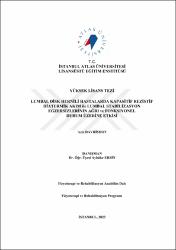| dc.contributor.author | Davrishov, Aziz | |
| dc.date.accessioned | 2023-10-05T14:10:35Z | |
| dc.date.available | 2023-10-05T14:10:35Z | |
| dc.date.issued | 2023 | en_US |
| dc.date.submitted | 2023-09-21 | |
| dc.identifier.citation | Davrishov, A. (2023). Lumbal disk hernili hastalarda kapasitif rezistif diatermik akım ile lumbal stabilizasyon egzersizlerinin ağrı ve fonksiyonel durum üzerine etkisi. (Yüksek lisans tezi, İstanbul Atlas Üniversitesi, İstanbul). Erişim adresi https://hdl.handle.net/20.500.12900/168 | en_US |
| dc.identifier.uri | | |
| dc.identifier.uri | https://hdl.handle.net/20.500.12900/168 | |
| dc.description.abstract | Araştırma ile lumbal disk hernili hastalara yönelik yüksek frekanslı diatermik akım tedavisi ve lumbal stabilizasyon egzersiz tedavisinin karşılaştırılması amaçlandı. Tüm katılımcıların demografik bilgileri sorgulandıktan sonra tedavi öncesinde ve tedavinin bitiminde aynı fizyoterapist tarafından fonksiyonel durumları Oswestry Bel Ağrısı Engellilik Anketi ile, ağrı seviyeleri Visual Analog Skalası (VAS) ile ve eklem hareket açıklıkları gonyometre ile değerlendirilmiştir. Çalışmamızda kapasitif ve rezistif diatermik akım tedavisinin ağrı, fonksiyonel durum ve eklem hareket açıklığı üzerine olan etkilerini araştırmak amacıyla 6 aydan uzun süreli bel ağrısı mevcut olan ancak nörolojik defisiti olmayan 30 hasta değerlendirildi. Hastalar randomize olarak 15' er kişilik 2 gruba ayrıldı. Deney grubuna lumbal stabilizasyon egzersizleri ve yüksek frekanslı diatermik akım, kontrol grubuna lumbal stabilizasyon egzersizleri uygulandı. Tüm katılımcılar tedavi öncesi ve tedavinin bitiminde değerlendirildi. Vizüel Analog Skala ile değerlendirilen ağrı parametresinde gruplar arasında istatistiksel olarak anlamlı bir fark bulunmadı (p>0,05). Oswestry Bel Ağrısı Engellilik Skalası'nın yürüme dışındaki alt parametrelerinin tümünde ve toplam skorlarının fark değerlerinde gruplar arasında istatistiksel olarak anlamlı bir fark bulunmadı (p>0,05). Eklem hareket açıklığı ölçümlerinin sonuçlarına göre deney grubunda kontrol grubuna kıyasla tedavi sonrası sadece gövde fleksiyonu eklem hareket ölçümündeki fark istatistiksel olarak anlamlı şekilde daha yüksekti (p<0,05). Gövde ekstansiyonu, gövde sağ ve sol lateral fleksiyonu eklem hareket açıklığı ölçümlerinin fark değerlerinde ise gruplar arasında istatistiksel olarak anlamlı bir fark bulunmadı (p>0,05). Sonuç olarak; LDH'li hastalarda kapasitif ve resistif diatermik akım tedaviye dahil edildiğinde rehabilitasyon sürecine katkı sağlayan, kolay uygulanabilir ve etkili bir tedavi yöntemidir. | en_US |
| dc.description.abstract | The aim of the study was to compare high frequency diathermic current therapy and lumbar stabilization exercise therapy for patients with lumbar disc herniation. After questioning the demographic information of all participants, their functional status was assessed with the Oswestry Low Back Pain Disability Questionnaire, pain levels with the Visual Analog Scale (VAS) and range of motion with a goniometer by the same physiotherapist before and after the treatment. To investigate the effects of capacitive and resistive diathermic current therapy on pain, functional status and range of motion, 30 patients with low back pain for more than 6 months but without neurologic deficit were evaluated. The patients were randomly divided into 2 groups of 15 patients each. The experimental group received lumbar stabilization exercises and high frequency diathermic current, while the control group received lumbar stabilization exercises. All participants were evaluated before and at the end of the treatment. There was no statistically significant difference between the groups in the pain parameter evaluated with the Visual Analog Scale (p>0.05). There was no statistically significant difference between the groups in all sub-parameters of the Oswestry Low Back Pain Disability Scale except walking and in the difference values of the total scores (p>0.05). According to the results of range of motion measurements, only the difference in the trunk flexion joint motion measurement was statistically significantly higher in the experimental group compared to the control group after treatment (p<0.05). There was no statistically significant difference between the groups in the difference values of trunk extension, trunk right and left lateral flexion range of motion measurements (p>0.05). In conclusion; When capacitive and resistive diathermic current is included in the treatment of patients with LDH, it is an easily applicable and effective treatment method that contributes to the rehabilitation process. | en_US |
| dc.language.iso | tur | en_US |
| dc.publisher | İstanbul Atlas Üniversitesi, Lisansüstü Eğitim Enstitüsü | en_US |
| dc.rights | info:eu-repo/semantics/openAccess | en_US |
| dc.subject | Lumbal Disk Hernisi | en_US |
| dc.subject | Lumbar Disc Herniation | en_US |
| dc.subject | Kapasitif Rezistif Diatermik Akım | en_US |
| dc.subject | Capacitive Resistive Diathermic Current | en_US |
| dc.subject | Lumbal Stabilizasyon Egzersizleri | en_US |
| dc.subject | Lumbar Stabilization Exercises | en_US |
| dc.title | Lumbal disk hernili hastalarda kapasitif rezistif diatermik akım ile lumbal stabilizasyon egzersizlerinin ağrı ve fonksiyonel durum üzerine etkisi = Effect of capacitive resistive diathermy current and lumbar stabilization exercises on pain and functional status in patients with lumbar disc herniation | en_US |
| dc.type | masterThesis | en_US |
| dc.department | İstanbul Atlas Üniversitesi, Lisansüstü Eğitim Enstitüsü, Fizyoterapi ve Rehabilitasyon Ana Bilim Dalı | en_US |
| dc.relation.publicationcategory | Tez | en_US |

















